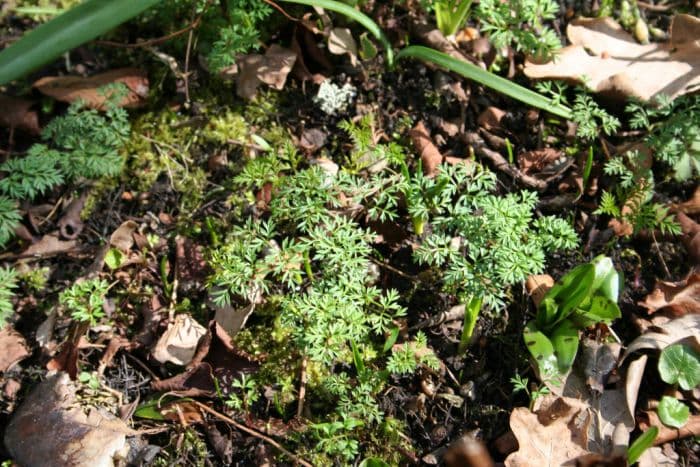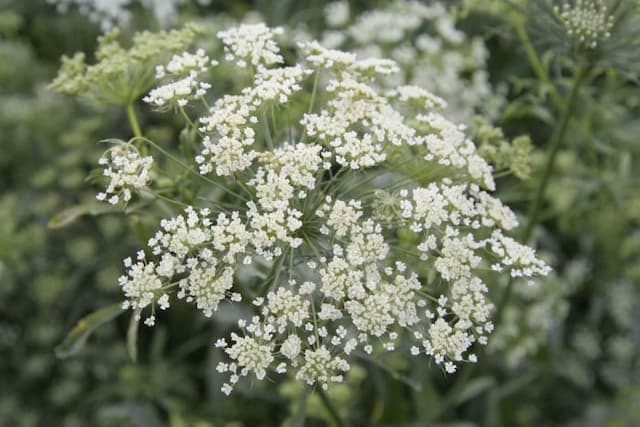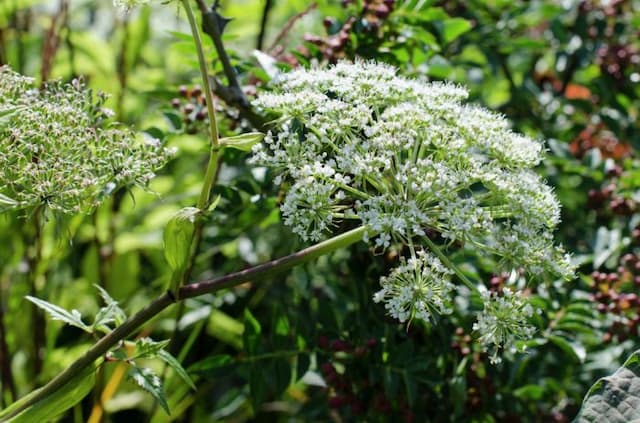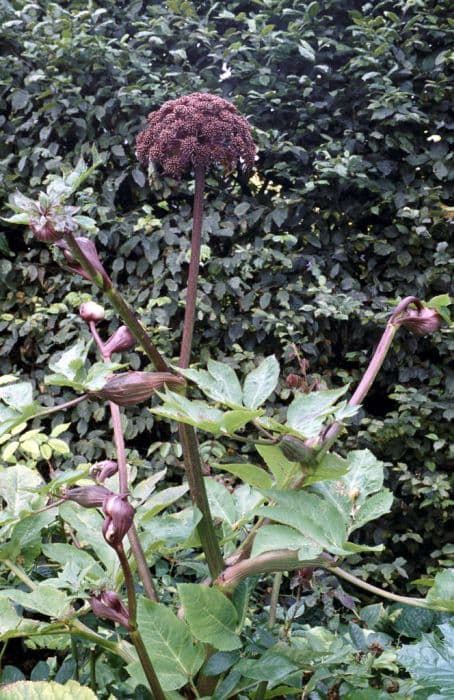Pignut Conopodium majus

ABOUT
Conopodium majus, commonly known as pignut, is a perennial plant characterized by its delicate and feathery foliage. The leaves of the pignut are pinnate, meaning they have a central stem with a row of leaflets arranged on either side. These leaflets are further divided into smaller segments giving the leaves an intricate, lace-like appearance. As the plant matures, it produces stems topped with small, white or cream-colored flowers. These flowers are arranged in an umbrella-like cluster known as an umbel, which is a typical feature of the family to which pignut belongs. The plant also develops an underground tuber that resembles a small nut, which is where the common name 'pignut' originates. The tuber is encased in a brownish, papery skin and is somewhat rounded in shape. Though its size is to be omitted, it's important to note that the appearance of the tuber has led to its name and significance for foraging in some regions.
About this plant
 Names
NamesFamily
Apiaceae.
Synonyms
Pignut, Earthnut, Groundnut, Arnut, Hawk's Nut, Kippernut, Kippernut, Earth Chestnut.
Common names
Carum bulbocastanum, Bunium bulbocastanum, Conopodium denudatum, Myrrhis bulbocastanum, Selinum bulbocastanum.
 Characteristics
CharacteristicsLife cycle
Biennials
Foliage type
Deciduous
Color of leaves
Green
Flower color
White
Height
1-2 feet (30-60 cm)
Spread
0-1 feet (0-30 cm)
Plant type
Herb
Hardiness zones
5
Native area
Europe
Benefits
 General Benefits
General Benefits- Edible uses: Conopodium majus, commonly known as pignut, produces tubers that can be consumed raw or cooked, offering a source of food.
- Culinary flavouring: The pignut's tubers have a sweet, nutty taste, making them a unique flavouring agent in culinary applications.
- Wildlife support: The plant provides food for various wildlife species, especially for foraging animals that consume its tubers.
- Ecosystem diversity: As part of the woodland undergrowth, pignuts contribute to the biodiversity of the habitat in which they grow.
- Ornamental value: With its delicate white flowers, pignut can add aesthetic value when grown in a naturalized garden or woodland setting.
- Traditional and cultural significance: In some areas, pignut has historical and cultural importance, used in traditional foraging practices.
- Pollinator support: The flowers of pignut can attract bees and other pollinators, supporting their populations and the wider ecosystem.
 Medical Properties
Medical Properties- Antispasmodic: Conopodium majus has been traditionally used to help relieve spasms in the intestinal tract.
- Carminative: The plant is known to help in the reduction of gas in the gastrointestinal tract.
- Diuretic: It has been used to promote the increased passing of urine.
- Expectorant: Conopodium majus is said to aid in the clearing of mucus from the respiratory tract.
- Stomachic: The plant has been used to support healthy stomach function and digestion.
 Air-purifying Qualities
Air-purifying QualitiesThis plant is not specifically known for air purifying qualities.
 Other Uses
Other Uses- Conopodium majus, commonly known as 'earthnut', has tubers that can be used as a substitute for chestnuts when roasted, giving a similar flavor profile.
- The earthnut's tubers can be ground into flour, offering an alternative gluten-free baking ingredient.
- In historical times, the tubers of earthnut were used as a famine food, providing nutrition in times of scarcity.
- Extracts from earthnut have been used as flavoring agents in specialty foods and beverages due to their nutty essence.
- Given their shape and consistency, earthnut tubers can be carved and used in craft projects for educational purposes, demonstrating root structures.
- The flowers of the earthnut plant can serve as a natural dye, providing a soft color for textiles and wool.
- Earthnut tubers can be mashed and mixed with other ingredients to create vegetarian patties or faux meatballs.
- Dried and powdered tubers of the earthnut have been historically used as a thickener in soups and stews.
- The seeds of earthnut can be used as an additive in potpourri blends, contributing an earthy aroma.
- Children have been known to playfully use the tubers as marbles, thus the earthnut also serves a recreational purpose.
Interesting Facts
 Feng Shui
Feng ShuiThe Conopodium majus, commonly known as pignut, is not used in Feng Shui practice.
 Zodiac Sign Compitability
Zodiac Sign CompitabilityThe pignut is not used in astrology practice.
 Plant Symbolism
Plant Symbolism- Survival: Conopodium majus, commonly known as pignut, often grows in tough, wild environments, symbolizing the ability to thrive in challenging conditions.
- Invisibility: The pignut's small, inconspicuous flowers and underground tubers represent things that are hidden or unseen.
- Hidden Treasure: Since pignuts are edible and found underground like hidden treasures, they are often associated with the idea of unearthing valuable assets or resources.
- Rural Simplicity: As a plant often foraged in the countryside, pignuts can signify a return to simple, rural living or a connection with nature.
- Foraging Skill: The skill required to identify and harvest pignuts without mistaking them for similar-looking toxic plants symbolizes knowledge and expertise in foraging and natural lore.
 Water
WaterFor pignuts, it is best to maintain consistent moisture in the soil without waterlogging. Water the plant deeply once a week, ensuring the entire root zone is moistened. During dry spells, you might need to water twice a week, providing the equivalent of at least one gallon of water per session. Cut back on watering during the fall as the plant prepares for dormancy. It's essential to avoid overwatering as pignuts do not tolerate soggy conditions well.
 Light
LightPignuts thrive best in dappled sunlight or partial shade conditions. They should be planted in a spot that imitates their natural woodland habitat, receiving filtered light rather than direct, intense sunlight. A location that provides morning sun and afternoon shade, or light filtered through a canopy of leaves, would be ideal.
 Temperature
TemperaturePignuts prefer moderate temperatures and can survive in a range roughly from 40 to 80 degrees Fahrenheit, but they grow best when the temperature remains between 50 and 70 degrees Fahrenheit. It is crucial to protect them from extreme cold and frost, as temperatures below 40 degrees Fahrenheit can harm or kill the plant.
 Pruning
PruningPrune pignuts primarily to remove dead or damaged stems and to maintain a tidy appearance. This light pruning can be done in late winter or early spring before new growth starts. There is no need for extensive cutting back except to control size if desired. The best time for pruning is when the plant is dormant.
 Cleaning
CleaningAs needed
 Soil
SoilPignut thrives in well-drained soil with high fertility, so a mix containing loamy soil, well-rotted organic matter like leaf mold or compost, and a balance of sand for drainage works best. The ideal soil pH for Pignut is typically between 6.0 and 7.0.
 Repotting
RepottingPignuts do not generally require frequent repotting. They can be left undisturbed for several years, as they prefer to establish themselves over time. Repotting is usually only necessary if the plant outgrows its container or the soil becomes exhausted.
 Humidity & Misting
Humidity & MistingPignut prefers a moderate humidity level, typical of outdoor environments. While specific humidity levels are not critical, it does well in the naturally fluctuating humidity of its native woodland habitat.
 Suitable locations
Suitable locationsIndoor
Grow Pignut in indirect light, keep soil moist, and ensure good air flow.
Outdoor
Plant Pignut in dappled light with well-drained, fertile soil.
Hardiness zone
5-9 USDA
 Life cycle
Life cycleConopodium majus, commonly known as pignut, is a perennial herbaceous plant that begins its life cycle as a seed which germinates in spring. Upon sprouting, it develops a rosette of pinnate leaves close to the ground. In the following years, it grows an underground tuber, which serves as an energy reserve, allowing the plant to survive winter dormancy. As it matures, usually in the second or third year, the pignut sends up a flowering stem in late spring to early summer, bearing small, white blooms in an umbrella-like cluster known as an umbel. After pollination, typically by insects, these flowers develop into small, oval-shaped fruits (seeds) that are dispersed to start the next generation. The plant dies back to its tuber each autumn, reemerging to continue the cycle the following spring.
 Propogation
PropogationPropogation time
Spring to early summer
Conopodium majus, commonly known as pignut, is generally propagated through seed. The best time to sow pignut seeds is in the fall, allowing for natural stratification during the colder months, which can break the seed's dormancy. To propagate pignut by seed, one must plant the seeds at a shallow depth of about 1/4 inch (around 6 millimeters) directly in the soil where they are to grow, as they do not transplant well due to a deep taproot system. Seed germination rates can be variable, and patience is required as the seeds can take several months to germinate. It's important to keep the soil moist during the germination period. Once sprouted, the young plants will take a couple of years to establish and produce the characteristic edible tubers. This method of propagation, while slow, requires little intervention and allows the pignut to naturalize in an appropriate woodland or meadow setting where they can thrive with minimal care.









